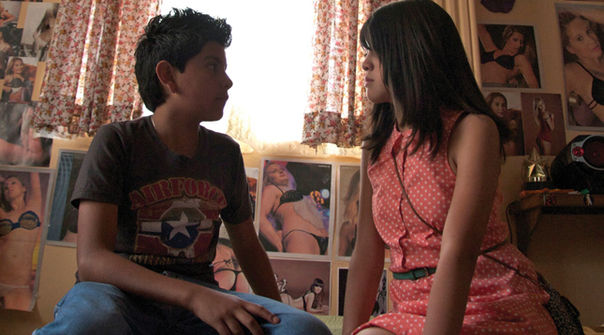Family: a patient in a dark room
Marianela González of the 2013 Guadalajara Talent Press reviews two takes on the Latin American family drama: Carlos Cuarón's BESOS DE AZUCAR and Marcelo Gomes' ERASE UNA VEZ YO, VERONICA.

Carlos Cuarón's BESOS DE AZUCAR.
It is about a first love in the corrupted and violent environment of a dysfunctional family, the stagnation of a society which protects a woman in maturity process, the strain of dealing with the loss of filial environment or plenitude space. BESOS DE AZUCAR and ERASE UNA VEZ YO, VERONICA are two beats of Carlos Cuarón and Marcelo Gomes about the trigger of the most frequent topics of Latin American cinematography of the 90s: family nucleus as epitome of the society.
Regarding the sensitivity of the point of view and the arguments, both films locate their characters in worlds they don't fit in: families as countries that reveal essential dramatic triggers. The Mexican one is inhabited by Nacho and Mayra (products of family nuclei which are closer to just a group of people under a same roof), marked by violence and asphyxiated by pa(ma)triarchy; in the Brazilian one, Veronica is a beloved daughter who goes from public to private, from standardization to liberty, from in definition to acceptance.
BESOS DE AZUCAR is a cinematographic cartoon of a Mexico in which everybody seems to deal stuff or to look away from the dealers. A film about redundant situations, a chaotic exposition of stories in which family nuclei are recycled from a "novelty" of the 90s: in tune with the crisis of familiar paradigm as a metonymy of the social and cultural crisis of the context; the characters that seem to be "the chosen ones" to keep hope of an uncertain faith are Nacho and Mayra, the lead characters of the last film of Cuarón.
When talking about Latin American drama, the film of Marcelo Gomes arises from the very moment of the dissection of a family in order to uncover social diseases. ERASE UNA VEZ… is not an apology to maturity nor a story of a family which goes beyond the twisted city. For Veronica, the object of desire and self-discovery are as tangible as sex, as true as the happiness she feels on her father's lap. The photography, the beauty and the magnetism of Hermilia redeem all possible "crimes" and give beauty to her body, her color, as well as to the body and colors of the city, every hope, every drop of vitality and every possible redemption.
Let death arrive when Veronica is unworried, when Nacho and Mayra have chosen to be free. There are things that carnivals don't cure, even though the sequences of this film say that carnival can cure anything thanks to the bodies and the energy - this is Marcelo's vision, an almost documentary point of view present in the whole film willing to anchor Veronicas nothing to Recife's nothing: the empty looks in the eyes of the hospital patients, the automatism of the workers of a cafeteria. The camera records the carnival and the sequence that steals even Veronica's leadership. turning her into a spin in the story.
The cyclic character of social processes, as well as of life around a genealogic tree, is placed back in the characters, giving a father and a daughter the chance to start over. The same happens when both adolescents escape in Cuaron's film, in front of a road that may have been the road of the girl who fires a gun. Both narrative structures provoke bitter-sweet feelings. However, whether the characters return to the start point or not, ERASE UNA VEZ YO, VERONICA and the idea of a Mexican "underworld" of salvation will arrive together with death in BESOS DE AZUCAR, both films return to the point where everything started: family as a possible way to achieve personal fulfillment and self-discovery; family as a contagious medium of an incurable social disease. In some way, we all are responsible... at least while the magic lasts inside the dark room.

